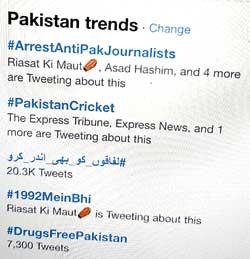31 Jul 2019 - {{hitsCtrl.values.hits}}

 Patriotic trolling, sounds a bit odd, but it is a very real, very common phenomenon. The last example from Sri Lanka was not so long ago. A woman complains on Facebook and Twitter that she would not support the car-free day, simply because she feels not being secure from the misogynistic public behaviour without the privacy of a car.
Patriotic trolling, sounds a bit odd, but it is a very real, very common phenomenon. The last example from Sri Lanka was not so long ago. A woman complains on Facebook and Twitter that she would not support the car-free day, simply because she feels not being secure from the misogynistic public behaviour without the privacy of a car.
Fair point or not, her views are contested not on their veracity, but by bringing her patriotic credentials into question, even going as far as to tell her to leave the country. That is a milder version of patriotic trolling. Milder because it did not escalate into a cacophony of name-calling, jeers, threats and vile remarks. But it could have.
And it did in Pakistan, where about a month ago the hashtag #ArrestAntiPakJournalists suddenly started trending. On July 3 at 11.00 pm this tweet appeared – “ Team @Ik_Warriors is launching a HT #ArrestAntiPakJournalists guys, grab your keyboards and start trending #ArrestAntiPakJournalists. There are hundreds of Pakistani journalists/anchors who are members of the pro-Indian, anti-Pak media group and they should be arrested.”
What followed is a case study of how a hashtag could be artificially manipulated and amplified, even for a short a time. According to Pakistan-based Digital Rights Monitor, the hashtag’s lifespan on twitter gave out indications that it was being amplified.
It started trending between July 4 and 5 and most of the interactions were retweets. Within an hour the tweets with the hashtag rose from 45 per hour to 4500.
According to Pakistan-based Digital Rights Monitor, the hashtag’s lifespan on twitter gave out indications that it was being amplified
“After an overall analysis of the hashtag data, it was clear that the hashtag was artificially amplified through an organized network of human-bots comprising approximately 600 to 800+ fake accounts. It was clear that nearly 800 accounts were posting 6+ tweets, and a substantial majority of contributing accounts had 50 to 200 followers on twitter – two classic traits of human-bot accounts.It was also obvious that the hashtag was initiated to intimidate journalists who were critical of the ruling party’s policies, especially with regards to the opposition,” Digital Rights Monitor noted.

Two of the journalists targeted “Hamid Mir’s twitter handle was mentioned, replied, tagged and/or re-posted in nearly 2100 tweets, and Asma Shirazi’s handle in 680 similar interactions.” The comments were not the flattering type.
The cyber trolling episode comes in the backdrop of increasing tensions and concerns over press freedom in Pakistan. Three prominent Pakistani journalists suspended using their twitter accounts, with several million followers, after messages that were conveyed to their organisations that their reporting was deemed anti-establishment.
What we see is a classic use of cyber tactics to match and enhance the offline environment, the cyber actions planned to compliment the offline atmosphere. With elections approaching, there is increasing attention on social media and impact in Sri Lanka where their influence will be felt unlike never before. Their popularity is what makes these dangers so potent.
Journalists in particular and others in general should be mindful of how social media can be manipulated. It is not that difficult to create mass hysteria on Facebook or Twitter. It only took 800 fake accounts to create a trend in Pakistan.
Last week, a racist video in which a man clearly made threats of mass attacks remained on Facebook for over 12 hours, was reacted to over a thousand times and shared even more. The engagement rates were in the millions and it took Facebook more than half a day to take it down! The language used was... Sinhala!
What becomes viral on social media is not what is positive. What becomes viral is what people like to watch and react to and the vilest content is sometimes the most attractive.
The writer is currently pursuing a Master by Research at CQ University, Melbourne on online journalism and trauma Twitter - @amanthap
26 Oct 2024 40 minute ago
25 Oct 2024 8 hours ago
25 Oct 2024 25 Oct 2024
25 Oct 2024 25 Oct 2024
25 Oct 2024 25 Oct 2024